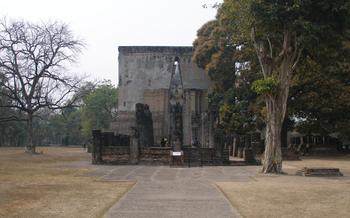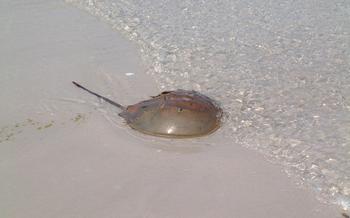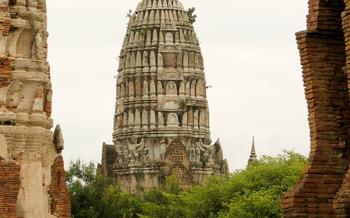
Wat Tham Khuha Sawan
- Stunning Buddha Images
- Exploring the Cave Complex
- Pilgrimage and Meditation
- Festivals and Celebrations
- The Surrounding Area
- Local Cuisine and Handicrafts
- Photography and Social Media
- Mindful Exploration
- Local Beliefs and Customs
- Sustainability and Conservation
- Insider Tip: Unveiling the Temple's Hidden Chamber
Stunning Buddha Images
Inside the cave, visitors are greeted by a breathtaking array of Buddha images, each radiating an aura of serenity and devotion. The most prominent among them is a colossal reclining Buddha, its sheer size and intricate detailing awe-inspiring. The reclining Buddha symbolizes the Buddha's entry into Parinirvana, the state of ultimate liberation from the cycle of rebirth. Its peaceful expression and serene posture evoke a sense of tranquility and remind visitors of the impermanence of all things.
Other Buddha images within the cave vary in size and posture, each exuding a unique charm and artistic expression. Some are seated in meditation, their hands gracefully positioned in the mudras of teaching, blessing, or contemplation. Others stand tall, their majestic presence commanding respect and devotion. The craftsmanship and artistry displayed in these Buddha images are a testament to the skill and devotion of Thai artisans.
Beyond their artistic value, these Buddha images hold deep religious and cultural significance for Thai Buddhists. They are believed to be imbued with sacred power and are often adorned with gold leaf and offerings of flowers, candles, and incense. Devotees pay homage to the Buddha images by prostrating themselves, chanting mantras, and making offerings, seeking blessings, guidance, and protection.
Exploring the Cave Complex
Wat Tham Khuha Sawan's cave complex is a labyrinth of natural chambers and tunnels carved by water over millions of years. The main cave, where the temple is located, is awe-inspiring in its size and grandeur. Its high ceilings and vast expanse create a sense of wonder and mystery.
As you venture deeper into the cave, you'll discover smaller chambers and tunnels, each with its unique features. Some chambers are adorned with Buddha images and colorful murals, while others are home to natural wonders like stalactites and stalagmites. The cave's walls are adorned with intricate carvings and inscriptions that tell stories of the temple's history and the monks who have resided here.
To fully explore the cave complex, it's recommended to bring a flashlight or headlamp. Be prepared for uneven surfaces and slippery rocks, as the cave floor can be wet and muddy. Sturdy shoes are essential for safe navigation.
While exploring the cave, take your time to appreciate the natural beauty and serene atmosphere. Listen to the gentle sound of water dripping from the cave's ceiling, and observe the intricate patterns formed by the stalactites and stalagmites. The cave's natural acoustics create a unique soundscape that adds to its mystical ambiance.
Pilgrimage and Meditation
Wat Tham Khuha Sawan holds a significant place as a pilgrimage site for Thai Buddhists and those seeking spiritual enlightenment. Pilgrims from all walks of life come to the temple to pay homage to the revered Buddha images and to make merit, a central concept in Thai culture. Merit-making involves performing good deeds, offering gifts, and observing Buddhist teachings to accumulate positive karma and bring blessings to oneself and others.
Meditation is an integral part of Thai Buddhism and is practiced widely at Wat Tham Khuha Sawan. The serene and peaceful atmosphere of the cave provides an ideal setting for meditation and contemplation. Visitors can find quiet corners within the cave to sit and meditate, seeking inner peace and clarity. Many experienced meditators and monks come to the temple to deepen their practice and attain higher levels of spiritual awareness.
Pilgrims and meditators often share their experiences and insights with others, creating a sense of community and spiritual connection. The temple's serene environment and the presence of revered monks and teachers make it a sanctuary for those seeking spiritual growth and renewal. Whether you are a seasoned practitioner or a beginner, Wat Tham Khuha Sawan offers a welcoming space for pilgrimage and meditation.
Festivals and Celebrations
Wat Tham Khuha Sawan comes alive during its annual festivals, which showcase the vibrant traditions and culture of Thailand. The most significant festival is the Bun Bang Fai, held in May or June, where locals pay homage to the temple and celebrate the beginning of the rainy season. During the festival, colorful rockets are launched into the sky, accompanied by lively music, traditional dances, and food offerings.
Another notable festival is the Kathin Ceremony, which takes place in October or November. This festival marks the end of the Buddhist Lent and is a time for monks to receive new robes and other necessities. During the Kathin Ceremony, the temple is adorned with colorful decorations, and a grand procession of offerings is made by the local community. Visitors can witness the chanting of monks, the تقديم of gifts, and the blessing of the robes.
These festivals are a wonderful opportunity to immerse yourself in the local culture and traditions. Visitors can participate in the festivities, make merit by offering food and other items to the temple, and experience the warm hospitality of the Thai people.
The Surrounding Area
Wat Tham Khuha Sawan is nestled amidst a stunning natural landscape that offers visitors a chance to immerse themselves in the beauty of Thailand's natural heritage. The surrounding area boasts lush forests, cascading waterfalls, and picturesque rice paddies, creating a serene and tranquil ambiance. Visitors can embark on hiking trails that wind through the verdant hills, offering breathtaking views of the surrounding countryside. The nearby Than Thong Waterfall is a popular spot for swimming and relaxation, where visitors can cool off and soak in the tranquil atmosphere. Local markets in nearby towns offer a glimpse into the daily life of the local community, where visitors can purchase fresh produce, handmade crafts, and local delicacies. Combining a visit to Wat Tham Khuha Sawan with these nearby attractions allows visitors to experience the rich cultural and natural diversity of the region.
Local Cuisine and Handicrafts
Indulge in the flavors of Ubon Ratchathani's local cuisine while visiting Wat Tham Khuha Sawan. The temple's surroundings are dotted with eateries serving authentic Thai dishes, from spicy papaya salad to fragrant curries. Try the regional specialty, "larb moo," a tangy minced pork salad, or savor the rich broth of "kuay tiew reua," a beef noodle soup.
Food offerings play a significant role in Thai culture, and visitors can make merit by offering food to the monks at the temple. Visitors can purchase offerings from local vendors or prepare their own vegetarian dishes to present to the monks.
The area around Wat Tham Khuha Sawan is also known for its exquisite handicrafts. Visitors can find a variety of handmade items, such as woven baskets, intricate silver jewelry, and colorful textiles. These handicrafts are not only beautiful but also support the local economy and preserve traditional skills.
Local markets, such as the Warin Chamrap Market, offer a vibrant atmosphere and a chance to interact with the friendly locals. Here, visitors can find fresh produce, local delicacies, and handcrafted souvenirs.
Whether you're a foodie, a culture enthusiast, or simply looking for a unique shopping experience, the surroundings of Wat Tham Khuha Sawan offer a delectable blend of flavors and treasures.
Photography and Social Media
Respectful Documentation:
Wat Tham Khuha Sawan encourages visitors to capture the beauty of the temple and its surroundings through photography. However, it's important to maintain a respectful and mindful approach when taking photos. Visitors should avoid using flash photography, which can be disruptive to the serene atmosphere and disturb other visitors. It's also essential to be mindful of the privacy of others and refrain from taking photos of individuals without their consent.
Social Media Etiquette:
When sharing photos or experiences from the temple on social media, it's important to be mindful of the temple's sacredness and the privacy of others. Avoid posting images that could be considered disrespectful or offensive. It's also advisable to tag the temple's official social media accounts or use relevant hashtags to help promote the temple and its cultural significance.
Preserving the Sacredness:
The temple's serene and sacred atmosphere should be respected and preserved. Visitors are encouraged to take a moment to reflect on the temple's significance and the teachings of Buddha before capturing their experiences. By practicing mindfulness and respecting the temple's guidelines, visitors can help maintain the spiritual integrity of this sacred site.
Mindful Exploration
Wat Tham Khuha Sawan is not just a tourist attraction; it is a sacred site of spiritual significance. As you explore the temple and its surroundings, it is important to approach your visit with mindfulness and curiosity.
Mindful exploration involves being present in the moment, paying attention to your thoughts, feelings, and surroundings without judgment. By doing so, you can deepen your connection to the temple and gain a greater understanding of its spiritual essence.
Here are some tips for practicing mindfulness during your visit:
-
Slow down and savor the moment. Take your time exploring the temple, paying attention to the details of the architecture, the Buddha images, and the natural surroundings.
-
Engage your senses. Notice the sounds, smells, and textures of the temple. Feel the cool breeze on your skin, the warmth of the sun, and the softness of the moss under your feet.
-
Be mindful of your breath. As you walk through the temple, pay attention to your breath. Notice the rise and fall of your chest, the inhales and exhales.
-
Be present. Try to stay present in the moment, without dwelling on the past or worrying about the future. Focus on your experiences at the temple and let go of any distractions.
By practicing mindfulness, you can transform your visit to Wat Tham Khuha Sawan into a truly transformative experience. It is an opportunity to connect with yourself, with the temple, and with the sacredness of the place.
Local Beliefs and Customs
Wat Tham Khuha Sawan is steeped in local beliefs and customs that reflect the deep connection between the temple and the community. One such belief is the power of the wishing well located within the cave complex. Visitors are encouraged to toss coins into the well while making a wish, with the belief that their wish will be granted if the coin lands in the center. This tradition symbolizes the belief in the temple's sacredness and the power of faith.
Another local custom is the practice of merit-making through the offering of food and other items to the monks residing at the temple. Merit-making is a central aspect of Thai Buddhism, and visitors can participate by purchasing offerings from the local market and presenting them to the monks during the morning alms-giving ceremony. This act is believed to bring good luck and blessings to the donor.
Local beliefs also surround the natural features of the cave complex, such as the stalactites and stalagmites. These formations are considered to be sacred and are often associated with spirits or deities. Visitors are encouraged to treat these natural wonders with respect and refrain from touching or damaging them.
By understanding and respecting the local beliefs and customs, visitors can gain a deeper appreciation for the cultural significance of Wat Tham Khuha Sawan and contribute to preserving its sacredness for future generations.
Sustainability and Conservation
Wat Tham Khuha Sawan takes pride in its efforts toward sustainability and conservation. The temple actively works to preserve the natural and cultural heritage of the area. Visitors can contribute to these efforts by being responsible travelers and minimizing their environmental impact. Simple actions like reducing plastic waste, conserving water, and respecting the local flora and fauna go a long way in preserving the temple's sacredness. By embracing sustainable practices, visitors can help ensure that future generations can continue to experience the beauty and serenity of Wat Tham Khuha Sawan. The temple also encourages visitors to support local businesses that prioritize sustainability, such as eco-friendly accommodations and restaurants that source ingredients from local farmers. Together, visitors and the temple community can work hand in hand to protect the environment and preserve the unique charm of this sacred place.
Insider Tip: Unveiling the Temple's Hidden Chamber
Beyond the main chambers of Wat Tham Khuha Sawan lies a hidden gem that few visitors know about—the secret chamber. Tucked away in a secluded corner of the cave complex, this chamber is a place of tranquility and solitude. Here, visitors can escape the crowds and immerse themselves in the serene atmosphere of the cave. To find the secret chamber, follow the path that leads behind the main altar and look for a narrow passageway on the left. As you enter the chamber, you'll be greeted by a breathtaking sight—a small, secluded pool of crystal-clear water surrounded by stalactites and stalagmites. The water is believed to have healing properties, and many visitors come here to bathe and meditate. If you're looking for a truly unique and spiritual experience, be sure to seek out the secret chamber during your visit to Wat Tham Khuha Sawan.




